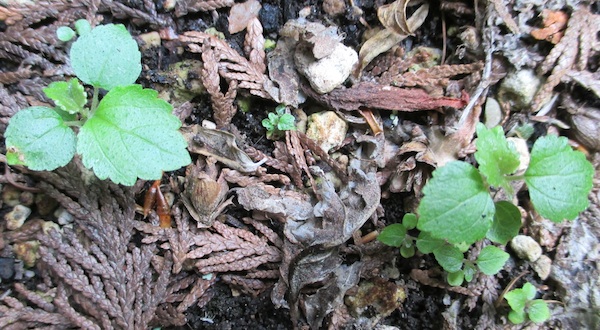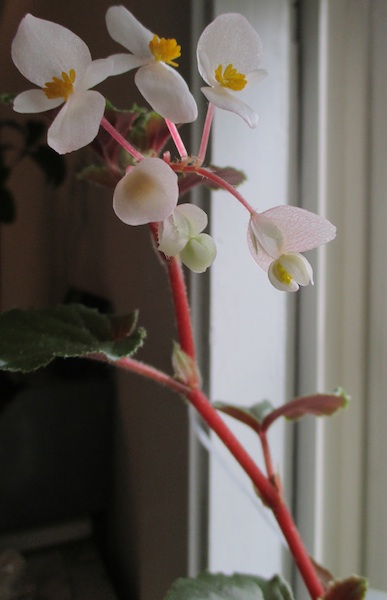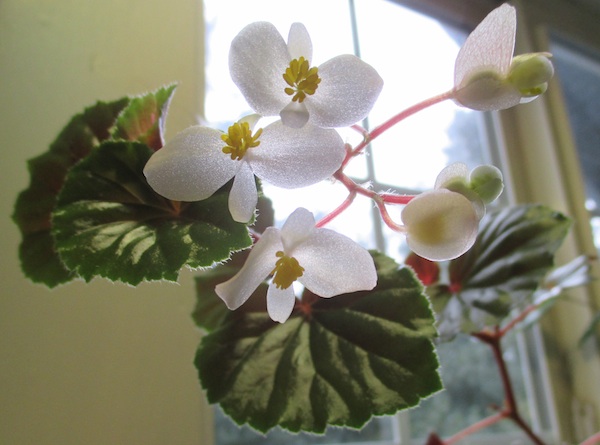Plant of the Month: March 2014
|
| Schmidt's Begonia |
| Begonia subvillosa Klotzsch 1855 |
| = Begonia Heineri Brade 1953 |
| = Begonia leptotricha C. DC. 1914 |
| = Begonia Schmidtiana Regel 1879 --usual name |
| = Begonia Schmidtii hort. F. Haage & E. Schmidt 1880 |
| = Begonia serafinensis Brade 1958 |
| = Begonia villosa Klotzsch 1854 |
BEGONIACEÆ; Begonia Family
|
| This is a story of a begonia plant that popped up wild in my houseplant collection. |
| In April 2010, I ordered via mail a Begonia acetosa, from Glasshouse Works nursery in Ohio. It arrived in May, grew for a while as a houseplant, then died. But as if in compensation for my loss, a Begonia seedling came up wild in a pot. I do not say that it was a Begonia acetosa seedling. For one thing, my plant never flowered; for another, my seedling did not look like Begonia acetosa. Moreover, I purchased other plants from many nurseries. So, I do not know where my seedling Begonia came from. But it finally flowered this month, so I could identify it, and hence write this article about it. |
| The genus Begonia consists of about 1,500 species, of tropical and warm regions, especially in the New World. People love them, and so now more than 10,000 cultivars have been named. Some are prized for their floral beauty, others for their exquisitely colorful and textured foliage. Only a few are fragrant. At least 69 species have been reported as eaten by people. Some are sold in markets for food; in Peru, some were consumed during the prehispanic period and have been found in archaeological excavations since 4,000 BC. |
| My begonia seedling, for four years, made only leaves. They are roundish, strongly cordate, up to 3 inches, and a dark glossy metallic green on top, dark glossy red beneath (with a pale green margin), and lightly hairy. The flowers are few, white and underwhelming. Yet without its flowers, I could not identify it. Even with flowers, it took me about an hour to figure it out. Had it been a rarer species, the job would have taken much more time. (Looking back, if I had fertilized the seedling differently, it would have bloomed earlier.) |
| The history of my wild species is more or less as follows. It was first collected in south Brazil by German naturalist Friedrich Sellow (1789 - 1831). The oldest name used, in 1854, was Begonia villosa Klotzsch. The plant has been mostly known as Begonia Schmidtii and Begonia Schmidtiana for years --after Erfurt nurseryman Ernst Schmidt (1834 - 1902). |
| Then, after 125 years of calm nomenclatural peace and quiet for Schmidt's begonia, there was a shake-up. A Portuguese study in the July-Sept. 2005 Brazilian Journal of Botany reported hairiness ranging from villous or tomentose to glabrescent; and that the plant grew not only in Brazil but also Bolivia, Argentina, and Paraguay; that several so-called species were, in fact, mere versions of a variable Begonia subvillosa named by Klotzsch in 1855. (But gardeners have used the name Begonia subvillosa for Begonia mollicaulis of Irmsch. 1957.) |
| The plant is often summer-dormant; its flowers can be pink or white. Most specimens are only about a foot tall, but flop and spread wider than tall. Northern gardeners planted it in the late 1800s, but it was quickly superseded by its hybrids called Wax Begonias. W. Falconer, of Glen Cove, NY, wrote in Popular Gardening and Fruit Growing, January 1888: "Its flowers are miserable little things." In her 1946 book Begonias and How to Grow Them, Bessie Wilson Raymond Buxton called Schmidt's begonia "weedy." |
| So, Schmidt's begonia is an ancestor of the popular Wax Begonias, and is nowadays considered not worth growing as an ornamental, being relatively leggy and less floriferous than its famous offspring. |
| I eat its leaves and find them pleasing in texture and acidic tartness. Their colorful beauty is also appealing in a salad or stir-fry. Patrick J. Worley, in the May 1976 The Begonian, wrote of eating the leaves: "very good, almost rivals B. deliciosa in flavor but otherwise less sweetish." |
| My specimen grew to 3 feet, then flopped, right after I photographed it. Since I enjoy eating its succulent leaves and tender stems, its paucity of blossoms is no problem. The plant is easy to grow. If mine sets seeds, I hope for offspring. |
If you eat Begonias, bear in mind that they are very acid --as rhubarb stalks--, contain oxalic acid, and ought be eaten sparingly. Also note that any plants you obtain from a florist or nursery may be contaminated with pesticides.
Back |

some Wax Begonia seedlings in a pot, outside, in Seattle, in June; photo by ALJ
|

Begonia subvillosa = Begonia Schmidtiana; photo by ALJ
|

Begonia subvillosa = Begonia Schmidtiana; photo by ALJ
|

Begonia subvillosa = Begonia Schmidtiana; photo by ALJ
|
|
|

